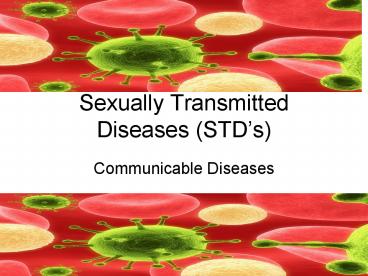Sexually Transmitted Diseases (STD - PowerPoint PPT Presentation
1 / 25
Title:
Sexually Transmitted Diseases (STD
Description:
Sexually Transmitted Diseases (STD s) Communicable Diseases What are they? STD s are infections spread from person to person through sexual contact. – PowerPoint PPT presentation
Number of Views:4436
Avg rating:3.0/5.0
Title: Sexually Transmitted Diseases (STD
1
Sexually Transmitted Diseases (STDs)
- Communicable Diseases
2
What are they?
- STDs are infections spread from person to person
through sexual contact. - STDs differ from other communicable disease in 2
important ways - 1. there are no vaccines (except for hep B)
- 2. your body can not build immunity to STDs
3
What you should know about STDs
- Learning the facts about STDs will help you
avoid them. - 1. Most STDs are spread only through sexual
contact - 2. You cannot tell if someone has an STD by their
appearance
4
Things to Know about STDs
- 3. A person with an STD may have no symptoms
- 4. Many STDs can be treated, but early diagnosis
is vital. - 5. Because treatments for STDs vary, they must
be accurately identified. - 6. STDs can recur because the body does not
build up immunity to them.
5
- 7. STDs are serious diseases that can cause
sterility, blindness, insanity, and death.
6
Practicing Abstinence
- When you practice abstinence, you avoid the
serious consequences of contracting an STD. - The ONLY SURE way to avoid STDs is to practice
abstinence from sexual activity. - SAYING NO to sexual activity will be one of the
most important health decisions you ever make.
7
Show your commitment to abstinence by
- Practicing RESPONSIBLE BEHAVIOR
- CHOOSE YOUR FRIENDS CAREFULLY
- AVOID BEING ALONE WITH A DATE
- KNOW YOU LIMITS AND COMMUNICATE THEM WITH YOUR
DATE BEFORE YOU GO OUT. - SAY NO THROUGH YOUR WORDS AND ACTIONS
- SEEK ADVICE FROM PARENTS/TRUSTED ADULT
8
Which scenarios show responsible behavior?
- Going out with a group of guys and girls together
- Hanging out with other people who dont share the
same beliefs and values that you do - Talking about situations that make you
uncomfortable - Wearing clothes that make you look older than you
are
9
Effective Communication
- Statements that someone might make to pressure
you into sexual activity include - If you really care about me, you would
- Everyone else is doing
- Sex can be safe
- HOW SHOULD YOU RESPOND?
10
Responses
- If you really care for me, you would respect my
decision. - Abstinence is the only sure way to be safe.
- The only thing that matters to me is what I
choose to do.
11
Remember
- Most teens arent having sex
- One quarter of all new cases of STDs occur among
15-19 year olds - Each year, about 4 million teens contract STDs
12
Common STDs
- See handout chart
13
HIV/AIDS
- AIDS or acquired immunodeficiency syndrome is a
deadly disease that interferes with the bodys
natural ability to fight infection. - The virus that causes AIDS is call HIV or human
immunodeficiency virus. - The only way to tell if a person has been
infected with HIV is through a blood test.
14
HIV/AIDS
- A person can be a carrier of HIV without having
AIDS. - A carrier is person who appears healthy but is
infected with HIV and can pass it to others. - A person can be a carrier for 10 or more years
before starting to show symptoms of AIDS.
15
How is HIV/AIDS spread?
- The primary way HIV is spread is through sexual
contact with an infected person. - AIDS is easily preventable through abstinence.
16
What HIV/AIDS does to the body
- HIV attacks the immune system.
- A damaged immune system can no longer fight the
pathogens that a healthy immune system would
destroy.
17
WHAT HAPPENS NEXT
- Shortly after being infected with HIV, some
people have flu-like symptoms. - These symptoms may disappear for months or years,
to be followed by the onset of AIDS itself. - A person with AIDS may have swollen lymph nodes,
fatigue, diarrhea, weight loss, and fever.
18
- To diagnose AIDS, doctors must determine whether
the persons t-cell count is below normal. - Another signal that AIDS has developed is the
presence of opportunistic infections. An
OPPORTUNISTIC INFECTION is an infection that
rarely occurs in healthy person. For example, a
type of pneumonia that can eventually cause death.
19
How HIV is spread
- HIV cannot survive in the air.
- It is passed from one person to another only in
bodily fluids-including blood, semen, and vaginal
secretions.
20
HIV infection can occur in the following ways
- Unprotected sexual contact with an infected
person - Piercing the skin with a needle that was
previously used by an infected person - Passage of HIV during pregnancy
- Transfusions
21
HIV is not spread by
- HIV is not spread through the air
- HIV not spread through closed mouth kissing
- Casual contact with an infected person (shaking
hands) - Mosquitoes that have bitten an infected person
- Sharing eating utensils
- Donating blood
22
Testing
- Blood tests detect the presence of antibodies to
HIV. - Be Aware that it may take up to six months after
infection for a blood test to detect antibodies.
23
Treatment
- AZT is an antiviral medicine that slows the
progress of HIV in the body. - Newer treatment involves combining medicines
called protease inhibitors and reverse
transcriptase inhibitors have allowed many AIDS
patients to live with their disease and keep it
under control.
24
Preventing the spread of HIV
- 1. Avoid sexual contact ABSTINENCE
- 2. Avoid drug use
- REMEMBER, HIV infection is still incurable and
AIDS is FATAL.
25
(No Transcript)

